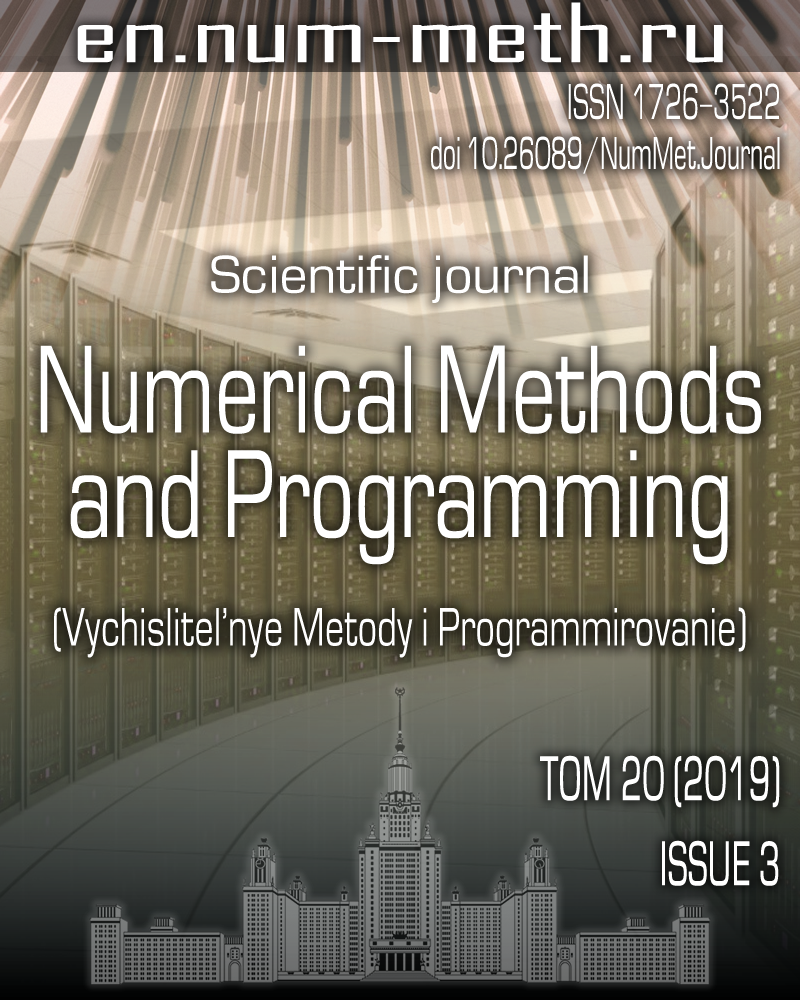DOI: https://doi.org/10.26089/NumMet.v20r322
Visualization of gas dynamics discontinuities in supersonic flows using digital image processing methods
Keywords:
Abstract
A number of approaches to the detection of features of gas dynamics fields obtained with shock-capturing methods are considered. In order to determine the location and type of gas dynamic discontinuities from the numerical solution, the ideas and methods of digital image processing are applied, in particular, the methods of detection of image contours based on the brightness of the image. Conditions of dynamic compatibility are used to classify gas the dynamic discontinuities, such as the normal shock waves, the oblique shock waves, the tangential discontinuities, the contact discontinuities, and the compression waves. The developed approach is not dependent on a specific type of the problem to be solved and is applicable to the calculations obtained with any shock-capturing method, facilitating and speeding up the processing of simulation results and increasing the objectivity of the interpretation of the results. Some examples of visualization of gas dynamic discontinuities arising in the diffraction and refraction of shock waves are given.
Downloads
Published
Issue
Section
References
- V. N. Uskov, One-Dimensional Theory of Laval Nozzles (Baltic Gos. Tech. Univ., St. Petersburg, 2005) [in Russian].
- Z. Wu, Y. Xu, W. Wang, and R. Hu, “Review of Shock Wave Detection Method in CFD Post-Processing,” Chinese J. Aeronaut. 26 (3), 501-513 (2013).
- K. N. Volkov, V. N. Emelyanov, I. V. Teterina, and M. S. Yakovchuk, “Methods and Concepts of Vortex Flow Visualization in the Problems of Computational Fluid Dynamics,” Vychisl. Metody Programm. 17, 81-100 (2016).
- E. V. Vorozhtsov, Classification of Discontinuities in Gas Flows as the Pattern Recognition Problem , Preprint No. 23-86 (Khristianovich Inst. Theor. Appl. Mech., Novosibirsk, 1986).
- S. B. Bazarov, “Application of Digital Image Processing for the Visualization of Gas-Dynamic Processes,” in Application of Scientific Visualization in Applied Problems (Mosk. Gos. Univ., Moscow, 2000), pp. 39-42.
- A. Hadjadj and A. Kudryavtsev, “Computation and Flow Visualization in High-Speed Aerodynamics,” J. Turbul. 6 (2005).
doi 10.1080/14685240500209775 - D. Lovely and R. Haimes, “Shock Detection from Computational Fluid Dynamics Results,” AIAA Paper (1999).
doi 10.2514/6.1999-3285 - R. Samtaney and N. J. Zabusky, “Visualization, Feature Extraction and Quantification of Numerical Visualizations of High Gradient Compressible Flows,” in Flow Visualization Techniques and Examples (Imperial College Press, London, 2000), pp. 317-344.
- M. Kanamori and K. Suzuki, “Shock Wave Detection Based on the Theory of Characteristics for CFD Results,” AIAA Paper (2012).
doi 10.2514/6.2011-3681 - M. Kanamori and K. Suzuki, “Shock Wave Detection in Two-Dimensional Flow Based on the Theory of Characteristics from CFD Data,” J. Comput. Phys. 230 (8), 3085-3092 (2011).
- E. V. Vorozhtsov, “On the Classification of Discontinuities by the Pattern Recognition Methods,” Comput. Fluids 18 (1), 35-74 (1990).
- A. Rosenfeld and A. C. Kak, Digital Picture Processing (Academic Press, New York, 1976).
- A. V. Mezhenin, Methods and Means of Pattern Recognition and Visualization (ITMO Univ., St. Petersburg, 2012).
- A. L. Afendikov, A. E. Lutskii, and A. V. Plenkin, “Wavelet Analysis of a Localized Structure in Ideal and Viscid Models,” Mat. Model. 23 (1), 41-50 (2011) [Math. Models Comput. Simul. 3 (4), 439-445 (2011)].
- P. V. Bulat, K. N. Volkov, and M. S. Yakovchuk, “Flow Visualization with Strong and Weak Gas Dynamic Discontinuities in Computational Fluid Dynamics,” Vychisl. Metody Programm. 17, 245-257 (2016).
- K. N. Volkov, V. N. Emel’yanov, I. V. Teterina, and M. S. Yakovchuk, “Visualization of Vortical Flows in Computational Fluid Dynamics,” Zh. Vychisl. Mat. Mat. Fiz. 57 (8), 1374-1391 (2017) [Comput. Math. Math. Phys. 57 (8), 1360-1375 (2017)].
- V. N. Uskov, Traveling One-Dimensional Waves (Baltic Gos. Tech. Univ., St. Petersburg, 2000) [in Russian].
- A. L. Andrianov, A. L. Starykh, and B. N. Uskov, Interference of Stationary Gas-Dynamic Discontinuity (Nauka, Novosibirsk, 1995) [in Russian].
- W. G. Habashi and P. L. Kotiuga, “Numerical Solution of Subsonic and Transonic Cascade Flows,” Int. J. Numer. Meth. Fl. 2 (4), 317-330 (1982).
- T. Yabe, F. Xiao, and T. Utsumi, “The Constrained Interpolation Profile Method for Multiphase Analysis,” J. Comput. Phys. 169 (2), 556-593 (2001).
- E. Yu. Echkina, S. B. Bazarov, and I. N. Inovenkov, Visualization in Research Studies (Mosk. Gos. Univ., Moscow, 2006) [in Russian].
- S. Cui, Y. Wang, X. Qian, and Z. Deng, “Image Processing Techniques in Shockwave Detection and Modeling,” J. Signal Inform. Process. 4 (3B), 109-113 (2013).
- K. N. Volkov, Yu. N. Deryugin, V. N. Emel’yanov, A. S. Kozelkov, and I. V. Teterina, Difference Schemes in Gas Dynamics on Unstructured Grids (Fizmatlit, Moscow, 2015) [in Russian].
- S. Osher and R. Fedkiw, The Level Set Methods and Dynamic Implicit Surfaces (Springer, New York, 2003).
- K. Takayama and O. Inoue, “Shock Wave Diffraction over a 90 Degree Sharp Corner,” Shock Waves 1 (4), 301-312 (1991).
- P. V. Bulat and K. N. Volkov, “Numerical Simulation of Shock Wave Diffraction over Right Angle on Unstructured Meshes,” Nauchno-Tekhn. Vestn. Inform. Tekhnol. Mekhan. Optiki 16 (2), 354-362 (2016).
- S. M. Liang and H. Chen, “Flow Visualization of Numerically Simulated Blast Waves Discharging from Open-Ended Duct,” AIAA J. 41 (12), 2420-2428 (2003).
- M. Van Dyke, An Album of Fluid Motion (Parabolic Press, Stanford, 1988).
- R. R. Nourgaliev, S. Y. Sushchikh, T. N. Dinh, and T. G. Theofanous, “Shock Wave Refraction Patterns at Interfaces,” Int. J. Multiph. Flow 31 (9), 969-995 (2005).
- P. V. Bulat and K. N. Volkov, “Numerical Simulation of Shock Wave Refraction on Inclined Contact Discontinuity,” Nauchno-Tekhn. Vestn. Inform. Tekhnol. Mekhan. Optiki 16 (3), 550-558 (2016).


